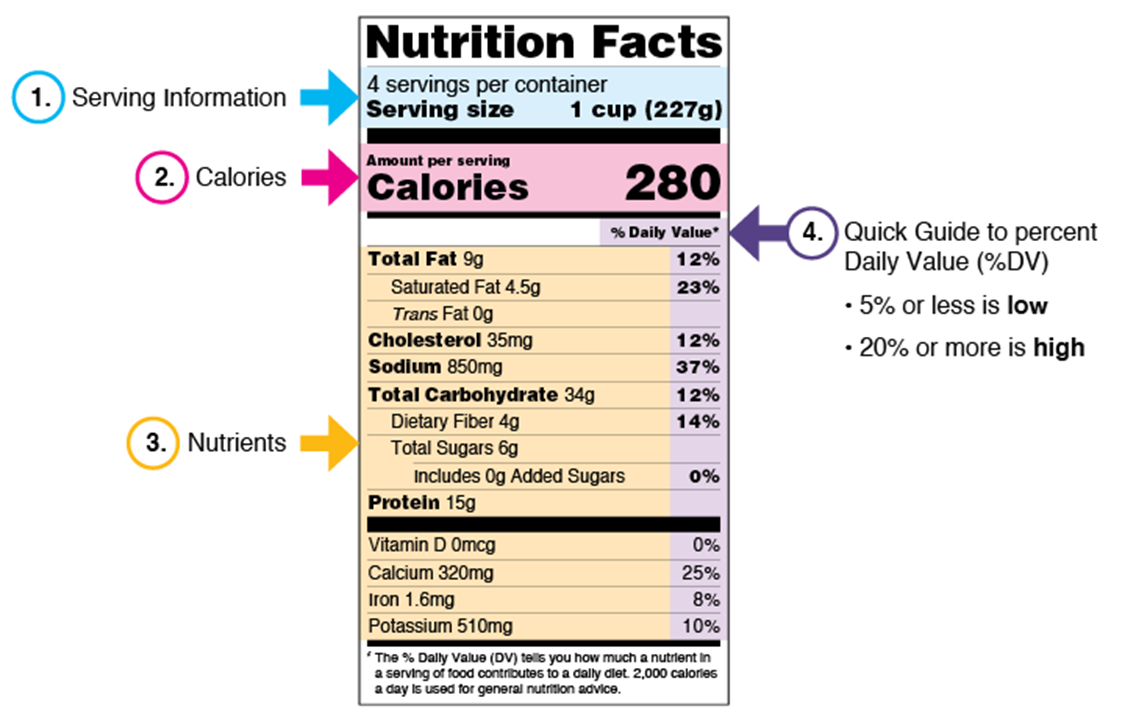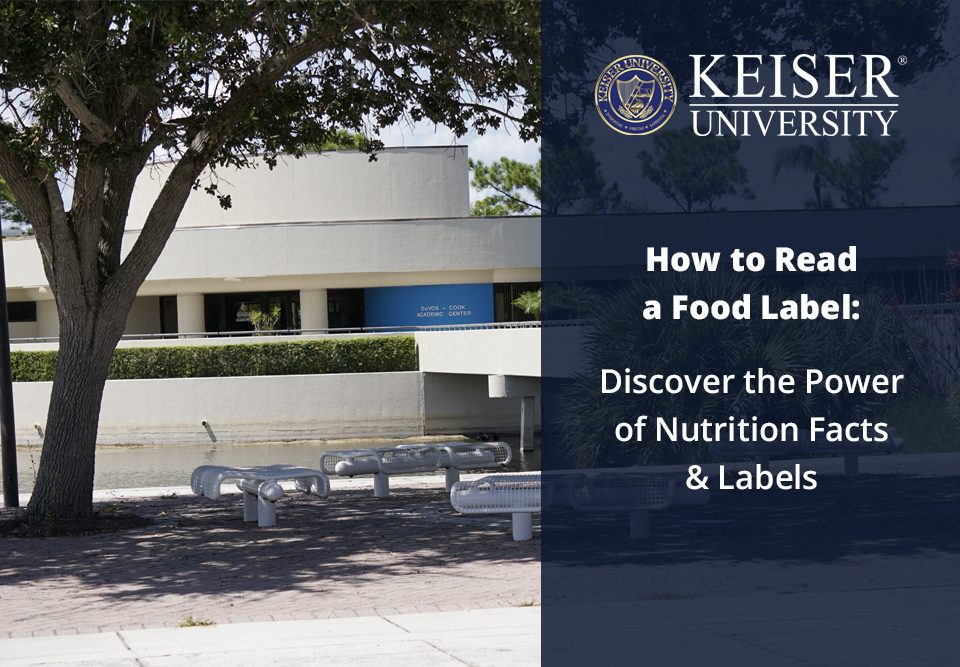Grocery shopping can feel surprisingly complicated these days. Bombarded with misleading nutritional information, we are often quick to glom onto the most visible health claims, with the assumption that the fewer calories (or the more vitamins) a particular product appears to have, the better it will make us look or feel. This can be true, but not necessarily — and often, we misinterpret product labels.
The good news? Reading a food label need not be overwhelming. With a little insight, these helpful labels can be powerful tools that clue us in on what exactly we are eating and how these foods can fuel our bodies. If understanding how to read a food label is confusing do not worry — we break it down in this helpful guide.
Why Are Food Labels Important?
Before you make a habit of reading food labels, it helps to know what function they serve. In turn, you will gain insight into how safe and nutritious various food products really are. These labels clearly outline what these products contain, both in terms of ingredients and nutrients.
If you are anything like most American adults, you already have a baseline familiarity with food labels. Findings from the Food Safety and Nutrition Survey (FSANS) indicate that 87 percent of US adults have examined these labels at some point. Many emerge feeling better informed and, therefore, better able to make healthy decisions.
Food and Drug Administration
The Food and Drug Administration (FDA) sets clear parameters for what must be included on food labels and how this information should be displayed. The current gold standard is the official nutrition facts label included with every food product. This originated with the Nutrition Labeling and Education Act of 1990 and, while it has undergone extensive revisions in the intervening years, should be familiar to most people.
Health Claims
Some food products are believed to prompt specific health benefits or even reduce the risk of developing various conditions. Currently, there are twelve health claims approved by the FDA. These claims are only eligible if there is significant scientific agreement (SSA) indicating high, evidence-backed confidence in a particular relationship with a substance and a health outcome.
These health claims can provide helpful insight but should not be the main consideration when selecting food products. Just because a food qualifies for a particular claim does not mean it is healthy. For example, a granola bar might be high in fiber and, therefore, great for heart health — but that same product may also have far more added sugar than recommended for a healthy diet.
Diet and Nutrition
With most consumers, the main goal when reading food labels is to determine the nutritional content of the product in question. Different people have different priorities, but metrics such as calories, serving sizes and grams of fat or sugar are often among the most sought-after. Ingredient lists can provide insight into nutritional value.
Examples of Food and Product Labels
When you picture the ‘typical’ food label, the standard nutrition fact chart featuring calories, serving size, fat and other key nutrients comes to mind. Products may contain other types of labels, but the nutrition label provides reliable nutrition information for the consumer.
Other food labels may be simpler, containing just one or two claims for marketing purposes. For example, many products may say dairy free for individuals suffering from lactose sensitivity and intolerance or gluten – free for gluten sensitivity or intolerance. These claims help individuals when purchasing products!
Front Labels
Currently, standard practice in the US is to highlight nutrition information on the back or side of food packages. This may eventually change, as research published in the Journal of Marketing suggests that consumers are more impacted by front-of pack labels (FoPL).
For now, in-depth nutritional information is rarely included on the front. Some products do follow a system known as “Facts Up Front,” in which select nutrition details are provided on the front label. Depending on the size of the package, this area may reference the number of calories, amount of sugar or daily value for a particular vitamin or mineral.
Beyond this, current requirements from the FDA mandate that the front label (also known as the principal display panel) clearly display the name of the product and the amount contained in the package.
Side and Back Labels
The side and the back are where the bulk of FDA-mandated nutrition information is currently found. There, you will discover lists of ingredients, along with required nutrition facts and a definition of the percent daily value. Other components include:
- Production, distribution and contact information
- Recommendations for storage
- Details about manufacturing, especially if this takes place in facilities that use eggs or nuts, to alert those with allergies.
Understanding a Food Label
Food labels are supposed to be easy to read and understand, however, there is a lot of information to take in. The information included on the label and packaging can be an opportunity for manufacturers to mislead consumers that food products are a lot healthier than they seem.
Food label literacy means not only examining the numbers and stats on the labels but also comprehending what they reveal about products’ nutritional value — and how all this plays in maintaining a well-rounded diet.
Elements of a Food Label
FDA-approved nutrition labels follow a standard format. An example of the official nutrition label is included to help guide you as you read further.
 Image Sourced from FDA.gov
Image Sourced from FDA.gov
When you examine these labels, you can expect to learn about the following:
- Serving size. This section reveals the amount of the product that is considered a serving size. For example, a serving size could be one-half cup, five crackers or eight ounces. Also included: the number of servings per container. This is often even more enlightening than the serving size. Keep in mind that this is not necessarily a recommended amount of food but rather a reference point to help you better understand the rest of the label.
- Fat. At one time, standard practice was to glance at this section and automatically opt for the foods with the fewest grams of fat. While this general category is worth a glance, understanding the amount of trans fats has become far more significant.
- Cholesterol. This remains a top category on nutrition labels, but the latest research suggests that it might not deserve all the attention it has traditionally received. In reality, other factors — such as sources and types of dietary fat — may play a greater role in our cholesterol levels. Still discussed with prediabetes, diabetes mellitus, hyperlipidemia.
- Sodium. Packaged foods tend to have elevated levels of sodium. This can prompt dehydration while also damaging the heart and kidneys over time. While reading food labels can increase awareness of sodium levels, cooking from scratch is another way to monitor sodium intake.
- Carbohydrates. Carbohydrates are not, as some dieters would tell you, all bad. Refined carbs like white flour/bread, cookies, pastries, and many cereals, however, are best avoided, as they provide limited nutritional value and tend to spike blood sugar. Food labels reveal total carbohydrates but also provide valuable insight into the amount of fiber.
- Sugars. These days, food labels offer insight into added sugars, with the understanding that an item that initially is high in sugar — fruit, for example — could be perfectly healthy, while something with less sugar per serving (candy or some cereals) may prove problematic if the sugar were added while preparing or processing the product.
- Protein. This section is one of the simplest and easiest to understand: protein is important nutrient for health, although it will not overcome issues such as elevated levels of sugar or trans fats.
- Vitamins & minerals. Near the bottom of the label, a variety of vitamins or minerals may be listed if these are present to any significant degree.
Reading the Ingredient List
There is more to food labels than fats, carbs, and vitamins. The ingredient list is a vital part of the label, as it lets you know what is in each product. When in doubt, the shorter the list, the better. Additionally, it is best if you can recognize and pronounce the ingredients.
Daily Values Percentages
The percentage daily value (%DV) helps consumers determine the amount of nutrients in a single serving of a particular food product.
The FDA bases these values on an ‘average’ diet consisting of 2,000 calories per day. Of course, ideal calorie levels will vary from one person to the next, based on everything from height and weight to age, physical activity, and many other parameters.
Daily values are useful not only for determining when to avoid going to excess (with, for example, sodium or added sugar) but also for gaining insight into your vitamin and mineral intake.
How to Properly Read a Food Label
Even if you know exactly what is contained in a standard food label and what each of the included terms means, you may still struggle to put all this information together and form any meaningful conclusions.
To expedite the process, scan from top to bottom, seeking the most important takeaways. For many people, this means seeking out the good, the bad and the ugly. For example: a quick glance at calories and added sugar should reveal how processed the product is, while vitamins near the bottom will let you know if there are any redeeming qualities.
Food Label Tips
Still struggling? The more often you practice reading a food label, the easier it is to make sense of this resource. We have compiled a few extra tips to help you understand how to read product labels:
- Pay attention to serving size. What initially appears to be a healthy choice may not seem so ideal upon examining the stated serving size, as these are often surprisingly small.
- Focus on the first few ingredients. While a shorter ingredients list is often preferable, the first two or three ingredients are always the most impactful.
- Compare several products from the same category. While an individual food label may not seem all that meaningful on its own, you will gain extra context by placing a few side-by-side. When purchasing salad dressing, for example, you can opt for the product with the fewest ingredients, the least amount of added sugar and the best sources of fat.
Become a Nutrition Expert at Keiser
If you are passionate about nutrition and eager to help others achieve a healthy lifestyle, the right degree program could change your life while also equipping you to do the same for others. Keiser’s top graduate programs encourage you to pursue your passion and make a difference in your community.
Our Master of Science in Clinical Nutrition Coordinated Program (MSCN-CP) integrates instruction and supervised practice to profound effect. Meanwhile, our Master of Science in Nutrition provides a valuable opportunity to complete a distance learning internship. This, in turn, will help you fulfill the requirements for eventually getting credentialed as a Registered Dietitian Nutritionist (RDN). Chat with a graduate counselor to determine which program is right for you.






 The instructors at Keiser University impacted my life. They believed in my ability to become a great graphic designer, regardless of how I felt about my skills. KU helped to prepare me for the real world and got me to where I am today.
The instructors at Keiser University impacted my life. They believed in my ability to become a great graphic designer, regardless of how I felt about my skills. KU helped to prepare me for the real world and got me to where I am today.
